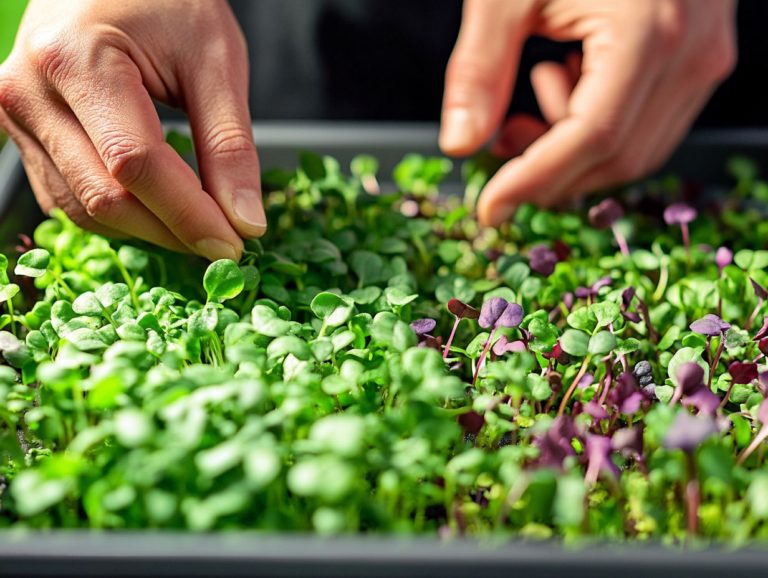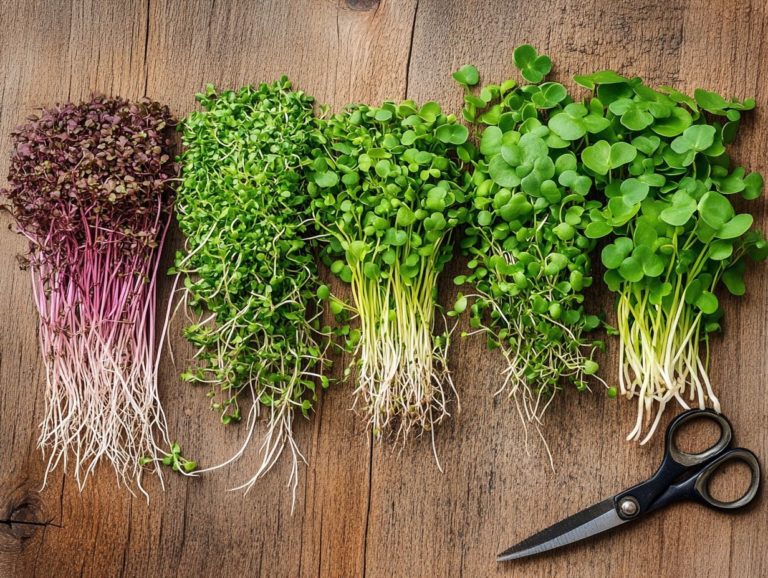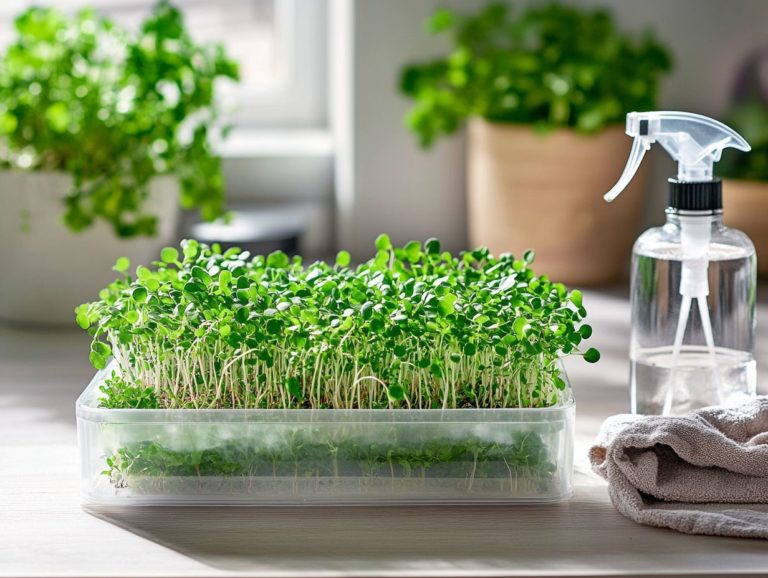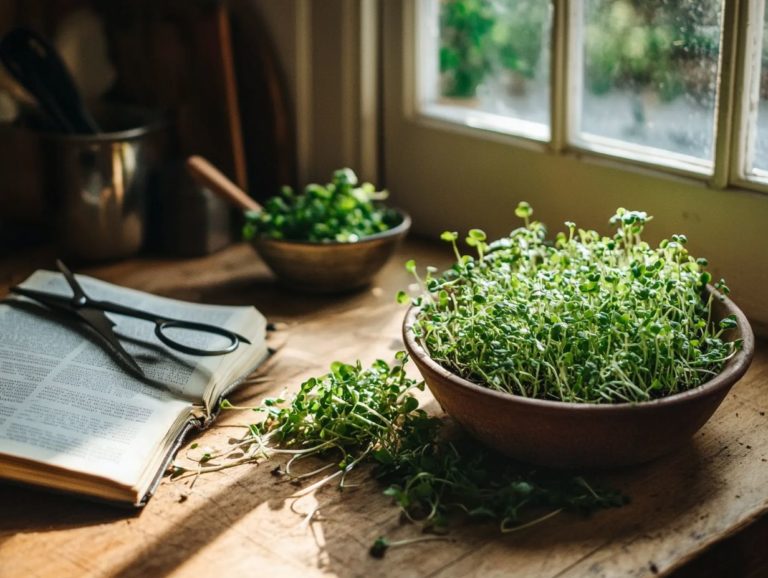Best Practices for Cleaning Microgreens Before Storage
Microgreens, rich in nutrients, are tiny, nutrient-packed plants that have taken the culinary world by storm. Their vibrant flavors and health benefits make them a favored choice for salads and garnishes. However, proper cleaning and sanitizing are essential before you indulge.
This article delves into the importance of cleaning and sanitizing microgreens, shedding light on potential health risks from germs and contaminants you may encounter. You’ll find effective cleaning and washing practices, proper storage techniques, and tips to keep your microgreens fresh for longer.
Get ready to elevate your microgreen experience!
Contents
- Key Takeaways:
- Why Cleaning Microgreens is Important
- Best Practices for Cleaning Microgreens
- Storing Cleaned Microgreens
- Tips for Maintaining Freshness
- Frequently Asked Questions
- What are the best practices for cleaning microgreens before storage?
- Why is it important to clean microgreens before storage?
- Can I use soap or detergent to clean microgreens?
- How should I dry microgreens before storing them?
- Should I remove any damaged or wilted microgreens before storage?
- How long can microgreens be stored in the refrigerator?
Key Takeaways:
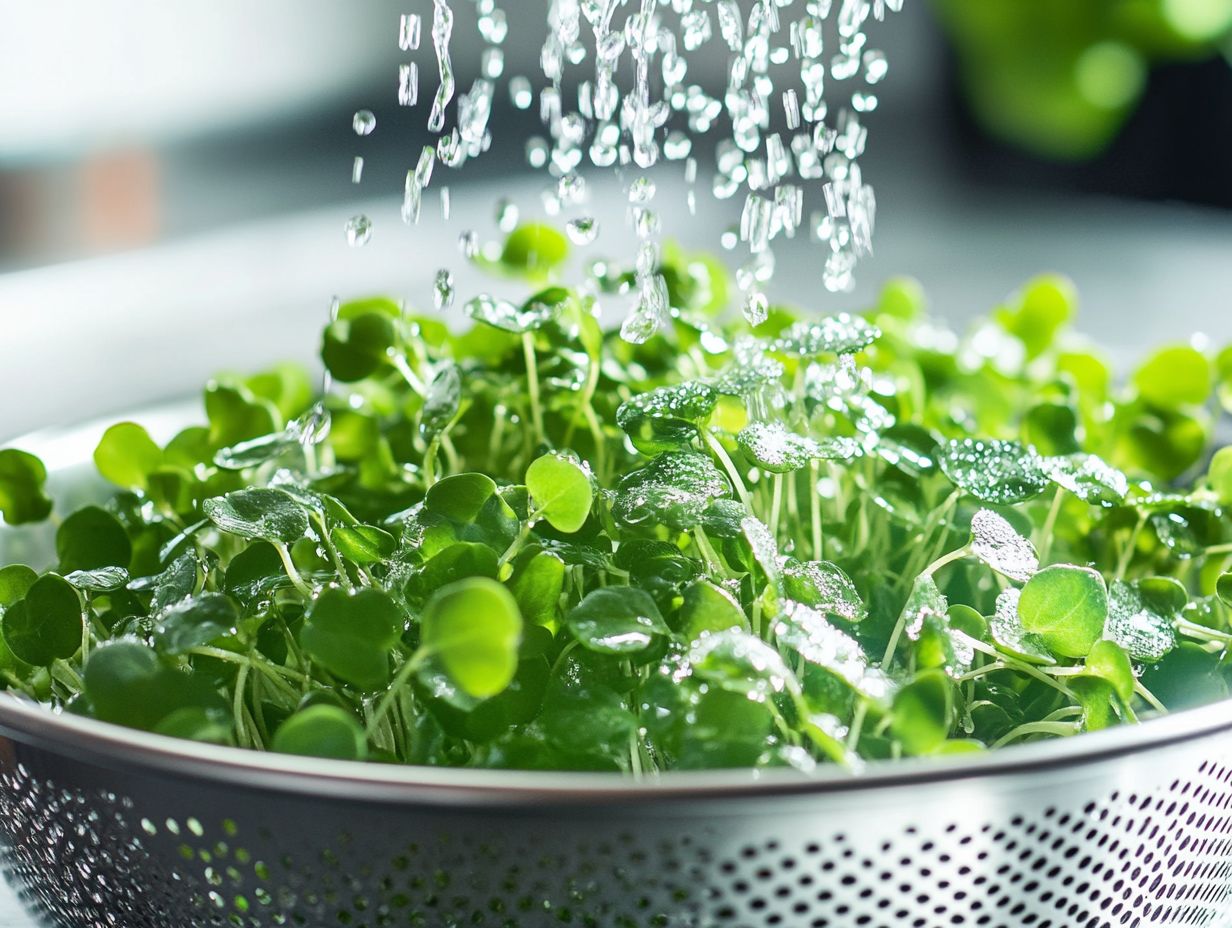
- Properly cleaning microgreens can reduce the risk of contaminants and ensure their safety for consumption.
- Follow a thorough step-by-step cleaning process to effectively remove dirt, bacteria, and other impurities from microgreens before storage.
- To maintain freshness and extend shelf life, store cleaned microgreens in a cool, dry place and avoid exposure to moisture or direct sunlight.
What are Microgreens? Learn how to properly clean and sanitize them!
Microgreens are those delightful young plants you can harvest just after they develop their first true leaves. They’re often bursting with nutrients and flavor, making them a fantastic addition to all sorts of dishes.
Some popular varieties you might want to try include Radish, Broccoli, and Pea Shoots, each offering unique tastes and vibrant colors.
You can grow them in a variety of mediums, which makes them accessible whether you re a home grower or working on a larger scale. Their freshness and health benefits are truly celebrated.
Beyond their culinary appeal, microgreens have impressive nutritional profiles. They often pack higher concentrations of vitamins, minerals, and antioxidants compared to their mature counterparts.
Take broccoli microgreens, for example; they’re particularly noted for their sulforaphane content, which is linked to a range of health benefits, including anti-inflammatory properties.
In terms of growing microgreens, you have options like hydroponics growing plants without soil, using nutrient-rich water soil, or even peat-based mediums. This flexibility allows you to choose your cultivation method.
This accessibility not only promotes healthier eating habits but also nurtures a deeper appreciation for gardening.
Why Cleaning Microgreens is Important
Cleaning microgreens is a crucial step in safeguarding food safety and preventing health risks from germs, especially for those who enjoy them fresh. Implementing proper cleaning and sanitizing methods is vital, whether you re a home grower or part of a commercial operation. This ensures you adhere to local health department requirements and regulations while delivering safe, nutrient-rich food.
By meticulously cleaning and sanitizing your microgreens, you can significantly reduce the risks associated with contaminants and maintain the integrity of your products.
Start cleaning your microgreens today for better health benefits!
Potential Contaminants and Health Risks
Microgreens can harbor contaminants that pose health risks. These include bacteria and pathogens that may lead to foodborne illnesses.
To reduce these risks, it s essential to clean thoroughly. Rinsing with cold water, using food-safe sanitizers, or opting for UV sterilization can enhance safety.
Be aware of other harmful agents like pesticide residues and soil-borne pathogens. Regular monitoring can provide peace of mind.
Soaking microgreens in a vinegar and water solution adds extra protection against surface pathogens. Always use clean utensils and surfaces to prevent cross-contamination.
By cleaning and sanitizing proactively, you can enjoy the nutritional benefits of microgreens without worry.
Best Practices for Cleaning Microgreens
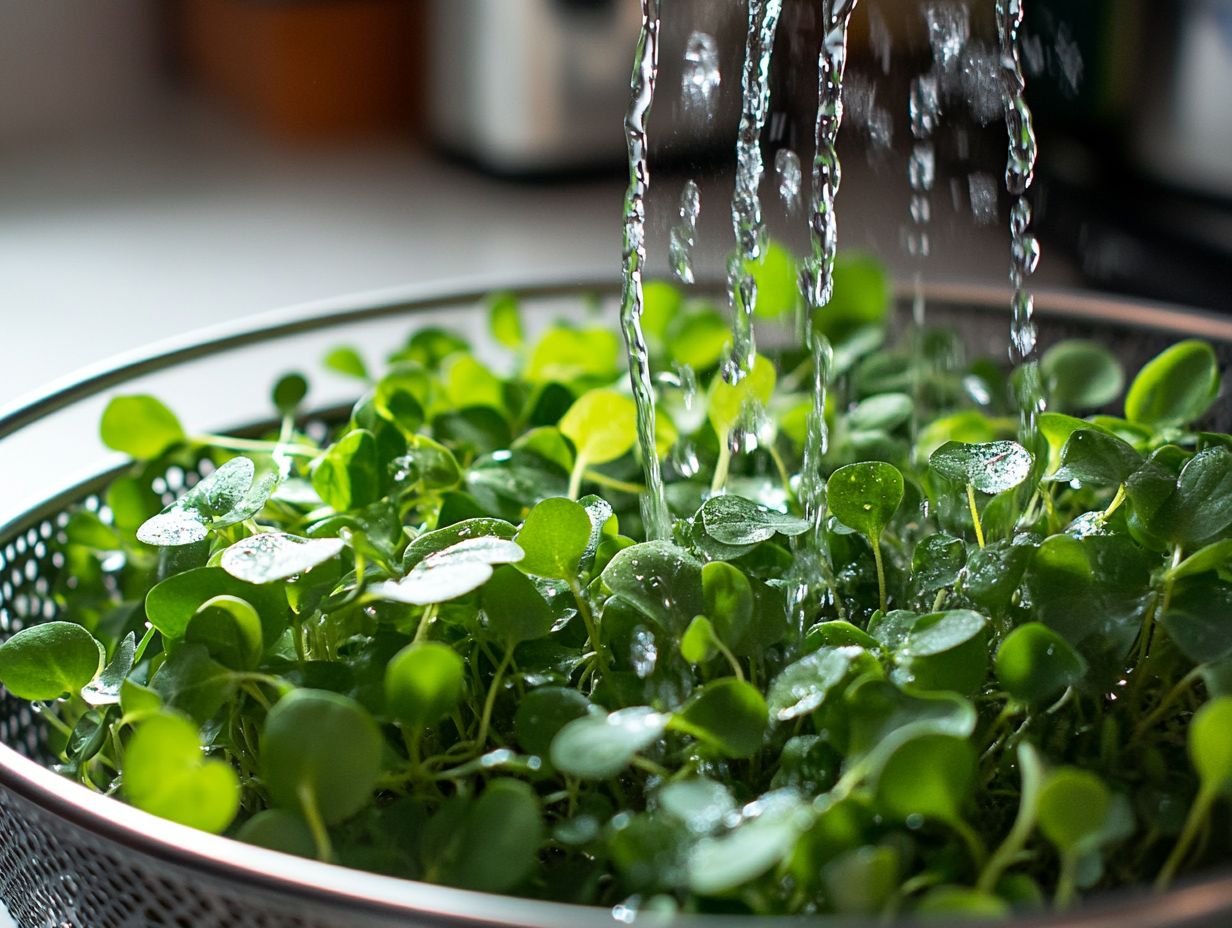
Implementing best practices for cleaning microgreens is crucial for maintaining their quality and ensuring consumer safety. Whether you re a home grower or a commercial producer, effective washing, scrubbing, and drying methods are key to removing debris and contaminants.
It s important to follow cleaning and safety rules to prevent cross-contamination. This not only enhances the overall quality of your microgreens but also boosts their freshness and nutrient density.
Step-by-Step Cleaning Process
The step-by-step cleaning process for microgreens starts with a thorough rinse under cold water to wash away any excess soil and debris. After rinsing, gently scrub the microgreens to dislodge any lingering particles.
This first rinse sets the stage for a thorough clean! Once you’ve scrubbed them clean, air drying is essential; it helps eliminate excess water that could lead to spoilage.
This initial rinse not only prepares for further cleaning but also gives you a chance to check for any blemishes or signs of spoilage. Ensuring every fiber of the microgreens is cleaned is vital for maintaining their vibrant flavor and crisp texture.
When laying the microgreens on a clean, dry surface for air drying, consider gently patting them with a towel or using a salad spinner to speed up the process. This extra attention significantly enhances their shelf life.
Storing Cleaned Microgreens
Proper storage of cleaned microgreens is crucial for preserving their freshness and minimizing spoilage. This ensures they remain a nutritious addition to your meals.
Following food safety guidelines is essential when storing microgreens; this includes maintaining an appropriate temperature and steering clear of excess moisture. Utilizing best practices for indoor microgreens and using suitable containers that allow for air circulation effectively safeguards their quality and prevents any premature degradation.
Proper Storage Techniques
Utilizing proper storage and drying methods can significantly enhance the freshness and shelf life of your cleaned microgreens, ensuring they remain nutrient-dense and flavorful. Key practices include using drying methods that eliminate moisture prior to storage and preparing them in a way that reduces bruising.
The type of containers you choose and their placement in the refrigerator can also greatly influence the overall quality and longevity of your microgreens. For optimal results, consider following the best practices for growing diverse microgreen varieties.
For instance, opting for breathable containers or trays designed for moist vegetables, such as perforated plastic bags or containers with ventilation holes, helps regulate humidity levels and prevents condensation that could lead to spoilage. Keeping your microgreens away from direct sunlight in the fridge ensures they maintain an optimal cool temperature. To learn more about maintaining freshness, it’s equally important to handle them gently during preparation to avoid bruising, as this can accelerate decay. Understanding how to store different microgreen varieties can also enhance their longevity.
Paying attention to these details makes a big difference. You can enjoy vibrant, fresh microgreens that are nutrient-dense for extended periods, adding both flavor and nutrition to a variety of dishes.
Tips for Maintaining Freshness
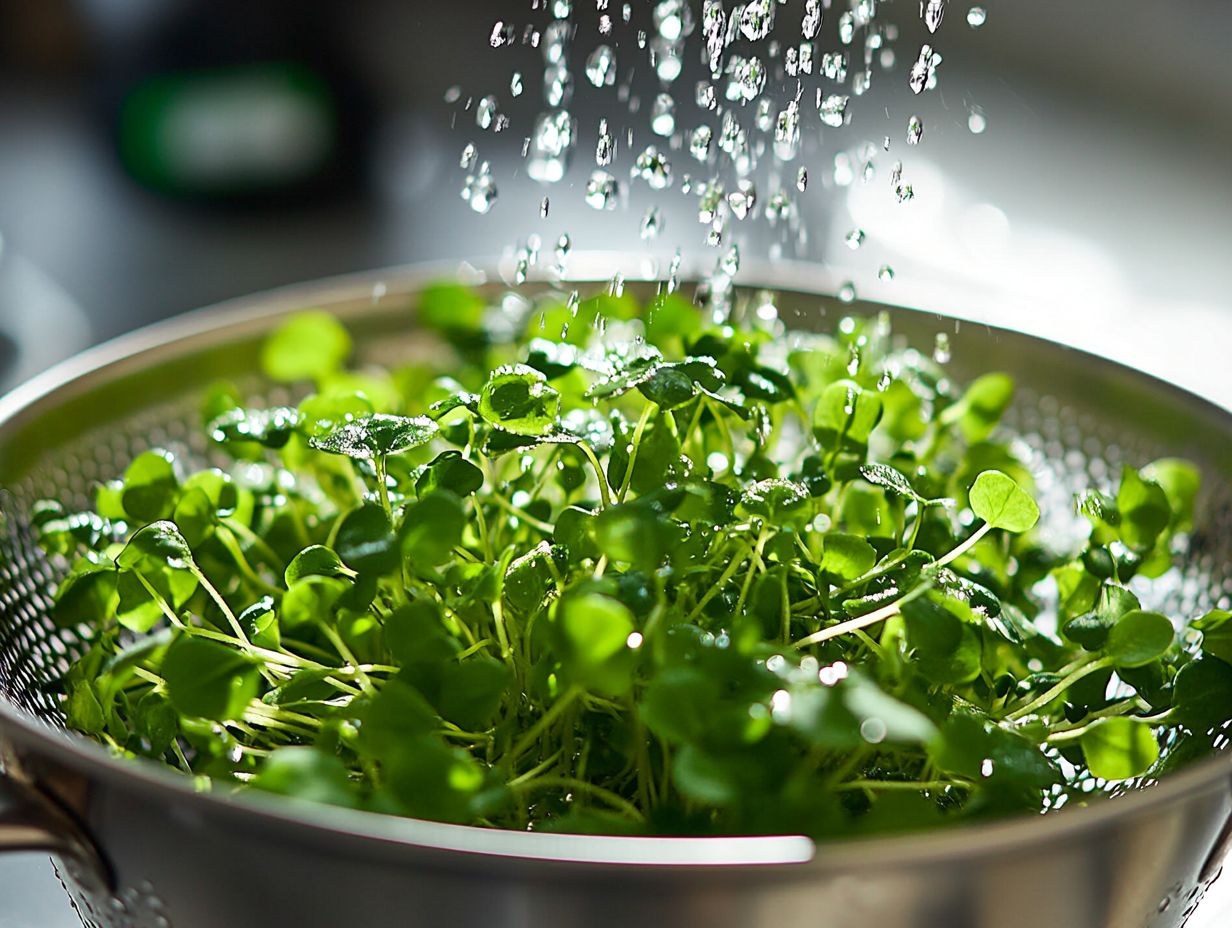
To keep your microgreens vibrant and fresh, it s essential to pay close attention to your storage and handling practices, preventing spoilage and extending their shelf life.
Consider these strategies for preserving their quality:
- Always use a clean tray for storage.
- Ensure they are thoroughly dried.
- Maintain optimal temperature control in your refrigerator.
Understand the unique needs of different microgreen varieties. Use specific cleaning and sanitizing practices for each type, ensuring they remain at their best for as long as possible.
Preventing Spoilage and Extending Shelf Life
To prevent spoilage and pathogen issues and extend the shelf life of your microgreens, use strategic methods focused on cleanliness and moisture control. Implement effective cleaning techniques before storage and ensure your microgreens are thoroughly dry to significantly minimize the risk of spoilage. Composting any waste not only promotes sustainability but also optimizes every aspect of microgreen growth and handling.
One essential strategy involves washing the microgreens carefully yet thoroughly, using a diluted vinegar solution to eliminate harmful bacteria and pathogens. After washing, it’s crucial to remove excess moisture with a salad spinner or a clean cloth, as dampness can lead to rapid spoilage. For optimal care, consider following the best practices for watering microgreens and storing your microgreens in breathable containers lined with paper towels to help absorb any lingering moisture.
Incorporating composting practices not only reduces waste but also enriches the soil for future growth, creating a harmonious cycle that benefits both the environment and your cultivation process.
Frequently Asked Questions
What are the best practices for cleaning microgreens before storage?
The best practices for cleaning microgreens before storage include rinsing them in cold water, gently patting them dry, and storing them in a sealed container in the refrigerator.
Why is it important to clean microgreens before storage?
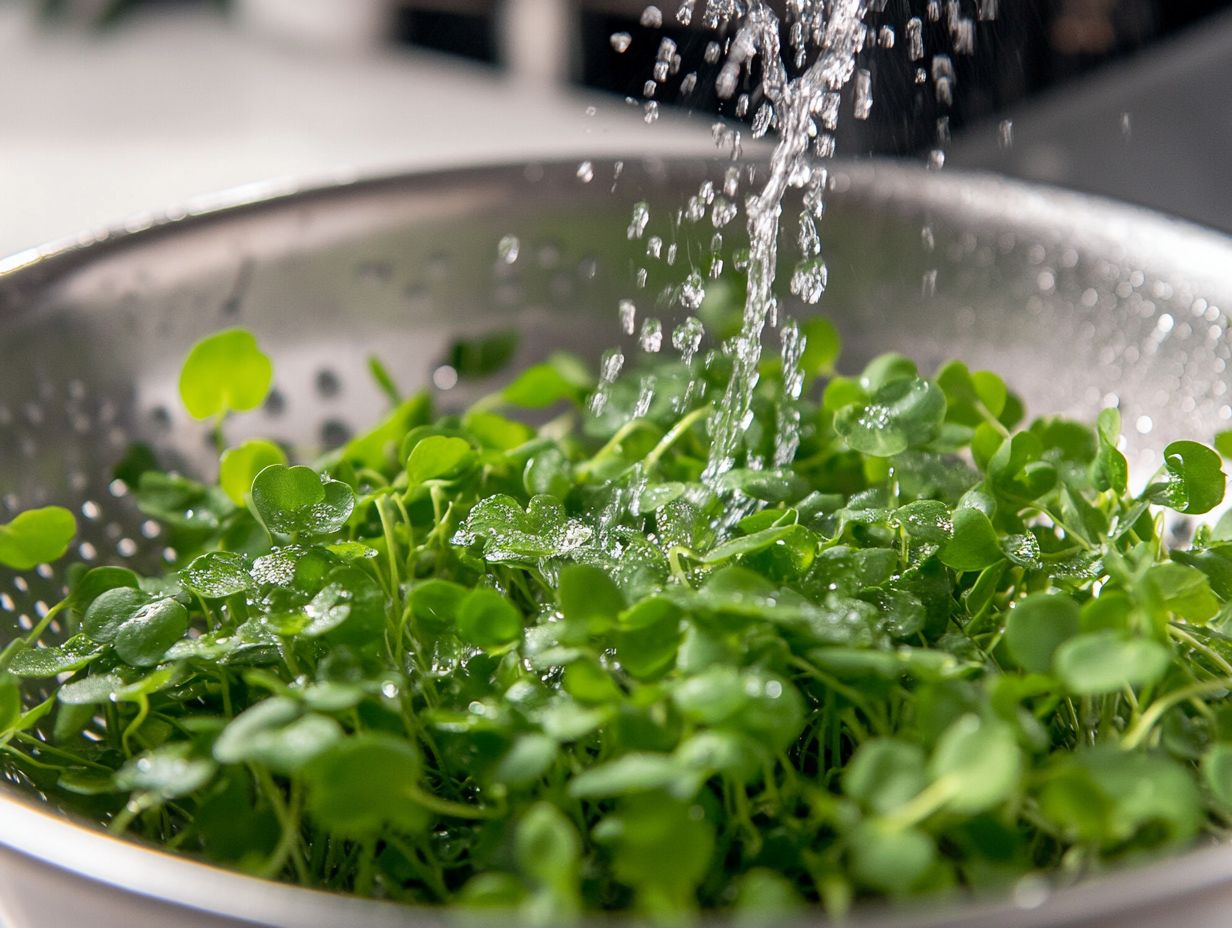
It is important to clean microgreens before storage to remove any dirt, bacteria, or residue that may be present on the surface. This helps prevent the growth of harmful bacteria and keeps the microgreens fresh for longer.
Can I use soap or detergent to clean microgreens?
No, it is not recommended to use soap or detergent to clean microgreens. These products can leave a residue and may contain chemicals that can be harmful if ingested.
How should I dry microgreens before storing them?
Gently patting the microgreens dry with a clean towel or using a salad spinner are both effective methods for drying microgreens before storage.
Try out these techniques today to enjoy fresh microgreens in every meal!
Should I remove any damaged or wilted microgreens before storage?
Yes, remove any damaged or wilted microgreens before storing them.
They can go bad quickly and may cause the others to spoil too.
How long can microgreens be stored in the refrigerator?
You can usually keep microgreens in the refrigerator for 5-7 days.
Always check them before use and throw away any that look bad.

